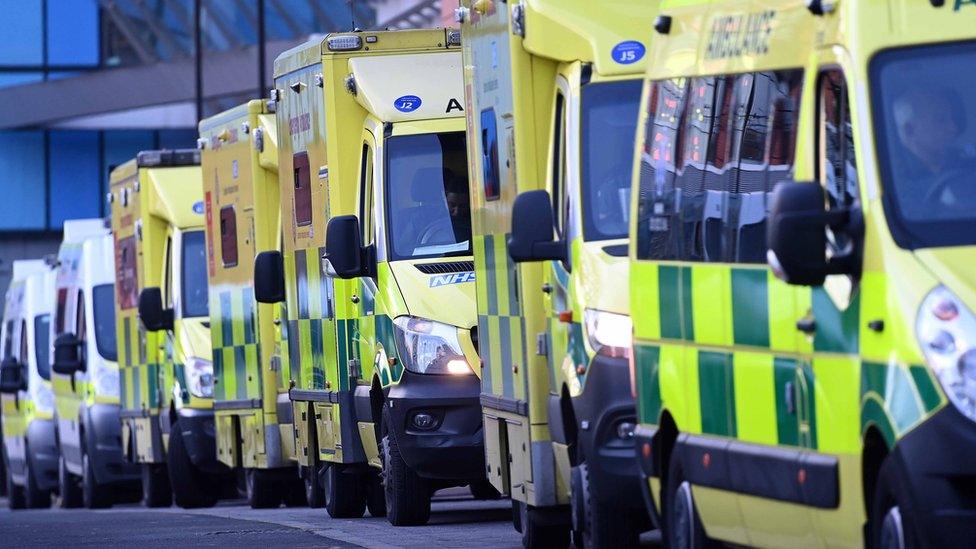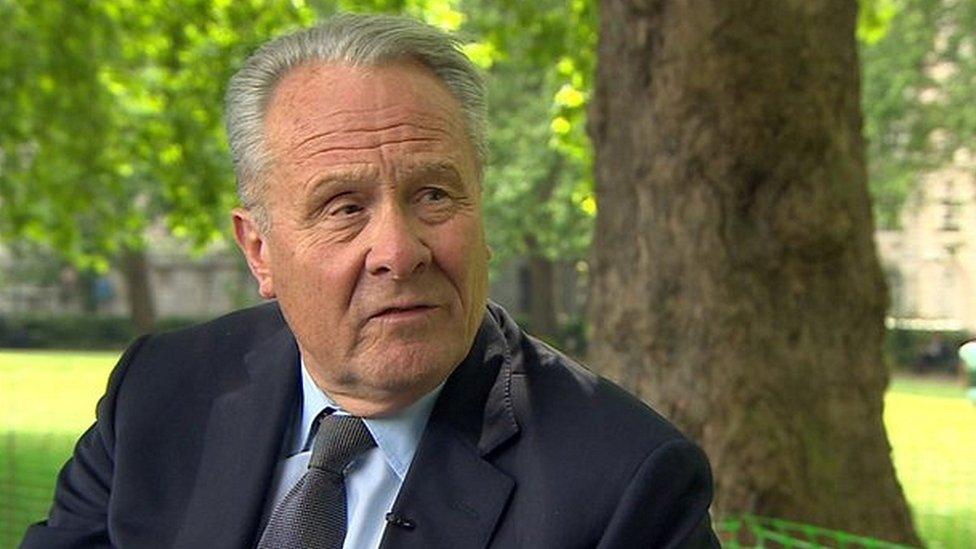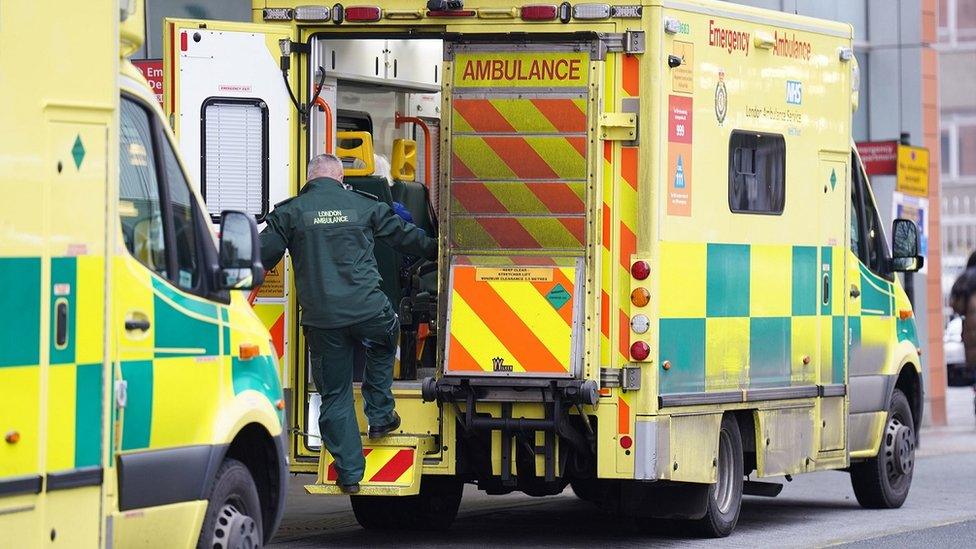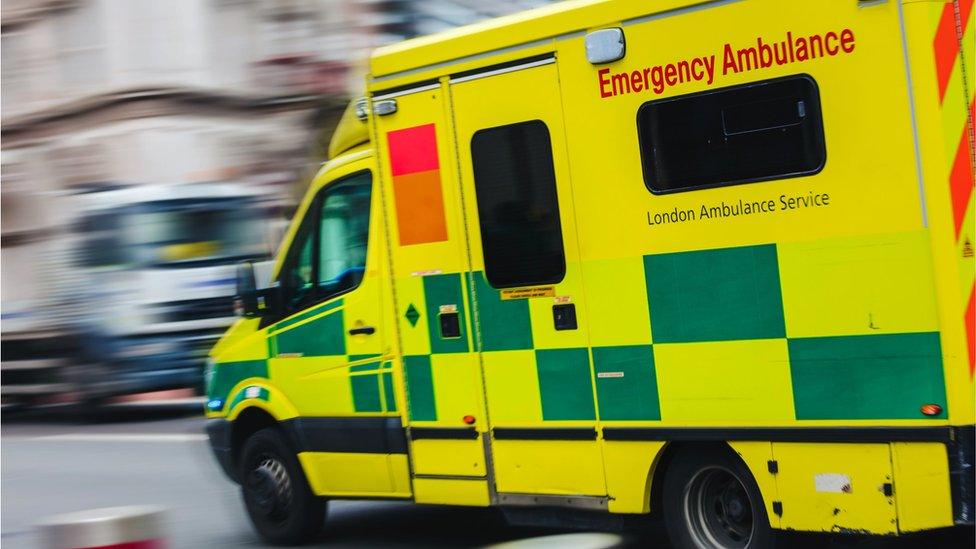England's new ambulance numbers not 800 promised, figures show
- Published

The government announced "over 800 new ambulances" in January
The number of new ambulances in England will be far less than the hundreds promised by the government, a Freedom of Information request has revealed.
In January, 800 new ambulances were announced, with a 10% fleet increase.
But vehicles being ordered by trusts are mostly replacements they were prevented from purchasing because of procurement changes and the pandemic.
NHS England said it was "delivering on its urgent and emergency care recovery plan".
Some orders had been "impacted by global supply chain pressures", it added.
In their FOI responses, eight of the 11 trusts in England said they planned to order 655 replacement ambulances in the years 2023-25 but only 51 new ones in total.
Two trusts, North West Ambulance Service and South Western Ambulance Service, have no plans to buy extra vehicles at all in the next two years.
North West declined to comment. South Western has been approached for a response.
Figures for vehicles funded by NHS England, obtained via another Freedom of Information (FOI) request by the BBC, also put new ambulance numbers at less than 800.
GMB union national secretary Rachel Harrison said: "The pledge of 800 new ambulances - much like the mythical new hospitals - was always an attempt to distract people from the root cause of problems in the NHS; overworked and underpaid staff."

Rishi Sunak announced the Urgent and Emergency Care recovery plan in January as he visited Teesside
The announcement by the Department of Health (DHSC) and NHS England, external referred to "increasing ambulance capacity" and said most of the new ambulances were expected to be available ahead of winter 2023-24.
But it has become clear "new" does not necessarily mean "extra" and NHS England said it accepted at the time some of this number would be replacements rather than additional vehicles.
In response to a written question, external in February the DHSC said the "over 800 new ambulances" advertised equated to about 350 extra vehicles, plus 100 mental health ambulances.
However, the FOI responses from England's ambulance trusts suggest the number of extra vehicles will be far fewer.
Double-crewed ambulances (DCAs) are normally replaced on a rolling basis to keep the age profile of the fleet at a set level. Yorkshire Ambulance Trust, for example, said it intended to replace about 59 of its fleet of 427 in 2023-24 to "keep an age profile of seven years".

Lord Patrick Carter advised on how hospital budgets could be better spent


The promise of 800 extra ambulances was the headline-grabbing initiative at the centre of the government's two-year plan to support A&Es and the wider emergency care system.
After a decade of near-continuous deterioration in performance, the government and NHS bosses set out in January a series of proposals to improve waiting times.
The small print on the day did make it clear that not all the ambulances would be new - nearly half were earmarked to replace existing ageing stock.
But the results of the BBC's Freedom of Information investigation suggest the number of new ambulances could be even lower than originally thought.
Not all services have finalised their plans - so the situation could still change.
But one of the problems ambulance bosses have run into is that delays in upgrading vehicles during Covid as well as a squeeze on spending in recent years has meant there is a greater number of older vehicles needing replacing than would normally be the case.

But, following a report in 2018, external which looked at ambulance procurement and running costs, NHS England told trusts to pause their replacement programmes while a new centralised contract was set up, the BBC has learned.
NHS England denies this, saying it had "never stopped trusts from buying or replacing ambulances". It did say orders had been affected by "global prices and supply chain pressures".
But some trusts have been unable to purchase any ambulances since 2019, with ordering only restarting at the end of last year. Using NHS England match-funding they are now catching up on orders for delayed replacements for vehicles that will come off the road.
Figures obtained via a FOI request to NHS England showed it was funding 382 vehicles over the period covered by the FOIs to trusts - 2023-25. But the body said it did not hold data on how many of these were replacements of old vehicles and how many were additional.
Comparing NHS England figures with trust FOI responses suggests many, if not all, are replacements. The number of vehicles NHS England is buying for the North East Ambulance Trust (NEAS), for example, matches the figure in the trust's FOI response for NHS England-funded replacements.

Replacement and extra DCAs planned for 2023-25 by the eight trusts that sent data
North West - 44 replacements, no extras
North East - 96 replacements, 19 extra + 6 spares
Yorkshire - 59 replacements, to be determined
West Midlands - 178 replacements, three extras
East Midlands - 55 replacements, 20 extras
South West - 200 replacements, no extras
East of England - 23 replacements, three extras
Four trusts have not returned data. Two others have not finalised numbers for 2024-25.

NEAS said it was receiving match-funding from NHS England to reduce its fleet age profile and would pay for the remaining DCAs from its normal replacement capital budget.
In its FOI response the trust said: "Our orders slipped by two years due to Covid, meaning we are running vehicles that are much older than we would normally.
"To reduce the risk of breakdowns, NHS England match-funding was provided and has enabled us to increase our orders to replace the vehicles that should have been replaced during the pandemic."
In a statement, director of finance and digital Tarryn Lake said "the replacement and further expansion of our ageing fleet" would benefit staff as well as patients.
"Reducing the age of the vehicles and expanding our fleet will mean that, over time, we will have a newer and more modern fleet," she said.

Follow BBC North East & Cumbria on Twitter, external, Facebook, external and Instagram, external. Send your story ideas to northeastandcumbria@bbc.co.uk, external.
- Published30 January 2023

- Published23 January 2023

- Published11 August 2022
